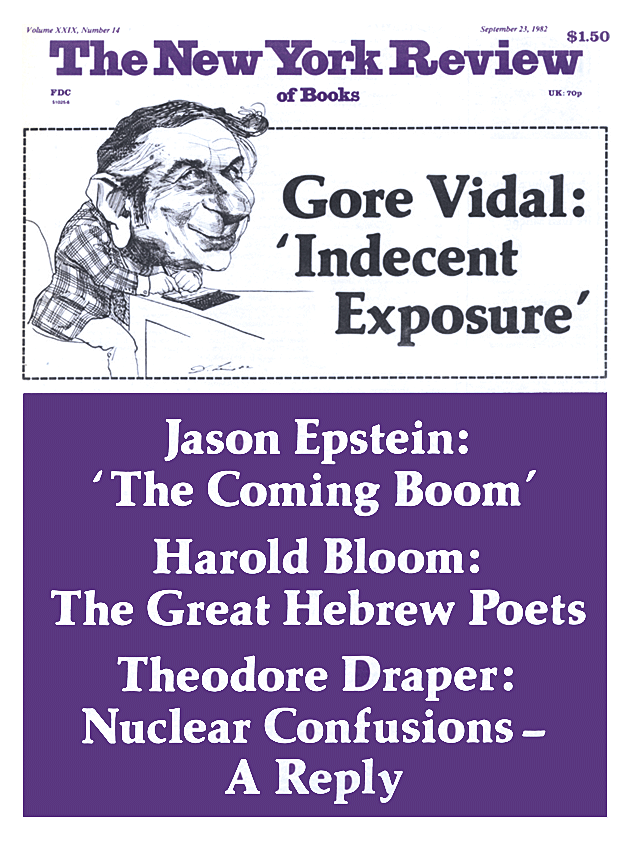In response to:
The Unhappy Medium from the May 27, 1982 issue
To the Editors:
I have to quibble about the quotation Messrs. Rosen and Zerner [NYR, May 27] extracted from my Horace Vernet catalogue preface as proof of what they consider my unique enthusiasm for the tepid art of the pompiers. By quoting me out of context, they managed to contradict my main point, since my comment that “in front of the paintings of Vernet the least curious of 20th-century spectators finds again the pleasure he feels before the great Romantic contemporaries Géricault and Delacroix” in no way refers to the mature Vernet, but only to his early work of c. 1815-1830, which does share the heated drama and turbulent facture so commonly admired in the Romantic generation and which even permitted Stendhal to describe Vernet in 1824 as the incarnation of youthful rebellion. But I then went on to contrast this with Vernet’s drastic change of style and emotion around 1830, explaining how this new world of the juste milieu, with its sober, impersonal chill and disjointed compositions, presents alien and initially unappealing visual territory which might, with sympathetic looking, yield unexpected clues to the origins of Courbet’s and Manet’s breakdown of traditional pictorial structure. The quote offered, then, had nothing to do with my response to Vernet’s juste milieu style, which is miles away from Géricault and Delacroix and calls for quite a different and more challenging approach.
This point may seem fine, but it’s important. Far from being what Messrs. Rosen and Zerner call “a maverick among neoconservative art historians,” I share with many art historians of my generation (and far more of a younger generation) a serious and often passionate concern with issues of historical reassessment and aesthetic discrimination in that vast body of art usually lumped together as pompler or academic. We have all been learning that this new Salon des Refusés turns out to be immensely various and susceptible to exactly the same qualitative range as any other art, from the authentic to the meretricious, from the original to the routine, from the beautiful to the dreary. (Couture and Gleyre, for instance, hardly make my pulse beat faster; but Gérôme and Leys do.) For most of us, an attraction to the other side of the nineteenth-century coin that was minted by early twentieth-century taste has nothing at all to do with either a campy penchant for kitsch or a stodgy distaste for the achievements of contemporary art. Students today who may love Pollock and Stella are quite capable of waxing enthusiastic over, say, Delaroche’s Lady Jane Grey, which, now out of storage, has become a show-stopper at the London National Gallery. For anybody under forty, in fact, the once-potent myth that avant-garde painting was the only guarantee of truth and beauty has become as archaic and useless as the myth that all nineteenth-century architecture which employed historical vocabularies belonged to an irrelevant and inferior breed that impeded the progress of the Modern Movement. What younger eyes want is more fresh, unprejudiced looking and fewer idées reçues about the exclusive residents of Mount Olympus.
Robert Rosenblum
New York University
New York, New York
Charles Rosen and Henri Zerner replies:
We only quoted Professor Rosenblum’s remarks as a rare example of open enthusiasm for an “official” artist. We apologize for not saying that he was speaking of early Vernet. About late Vernet, he uses the familiar and dubious neoconservative strategy: admitting that it looks terrible at first sight (“initially unappealing”), he suggests that if one tries hard (“with sympathetic looking”) one can make out a case for it as one of the “origins” (model? inspiration?) of avant-garde innovation.
Professor Rosenblum does himself less than justice: he is neither the simple mainline neoconservative that he pretends or the swinging elder statesman evoked by his repeated claims of solidarity with “art historians…of a younger generation” and “anyone under forty,” but an original and sometimes brilliantly eccentric critic, distinguished among other things for his persuasive work on the late eighteenth and early nineteenth centuries as well as for his astonishingly early and penetratingly intelligent recognition of Jasper Johns, Roy Lichtenstein, and Frank Stella.
We have never claimed that “avant-garde painting was the only guarantee of truth and beauty”; we have merely argued at length that recent tendentious attempts to deny the traditional and “mythical” opposition between avant-garde and official art make some of the most important aspects of nineteenth-century art unintelligible.
Delaroche’s Execution of Lady Jane Grey is a splendid piece of nineteenth-century kitsch that has always been popular with the general public whenever it was displayed. In calling it a “show-stopper,” Professor Rosenblum has found the only appropriate tone for a discussion of this work.
This Issue
September 23, 1982


